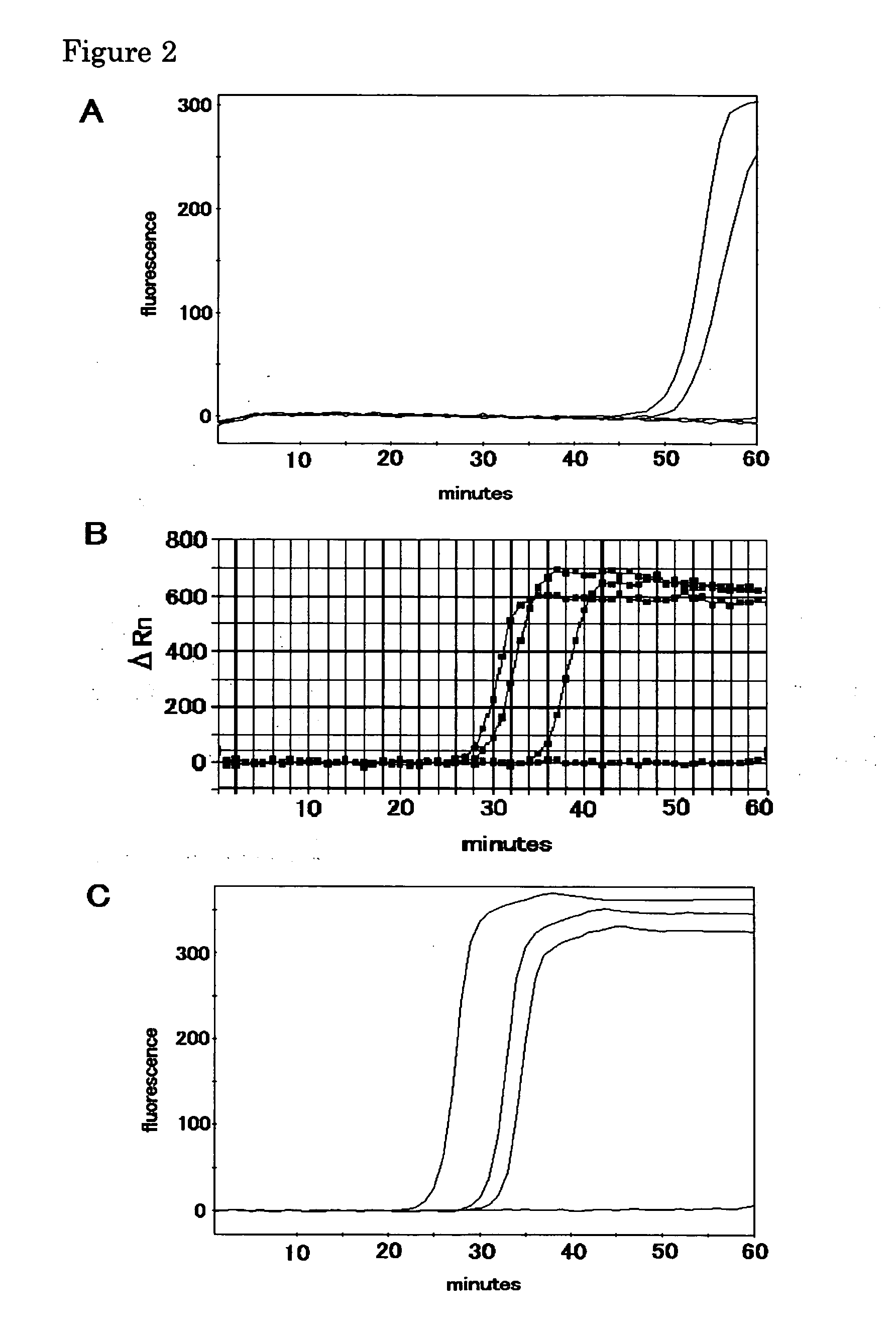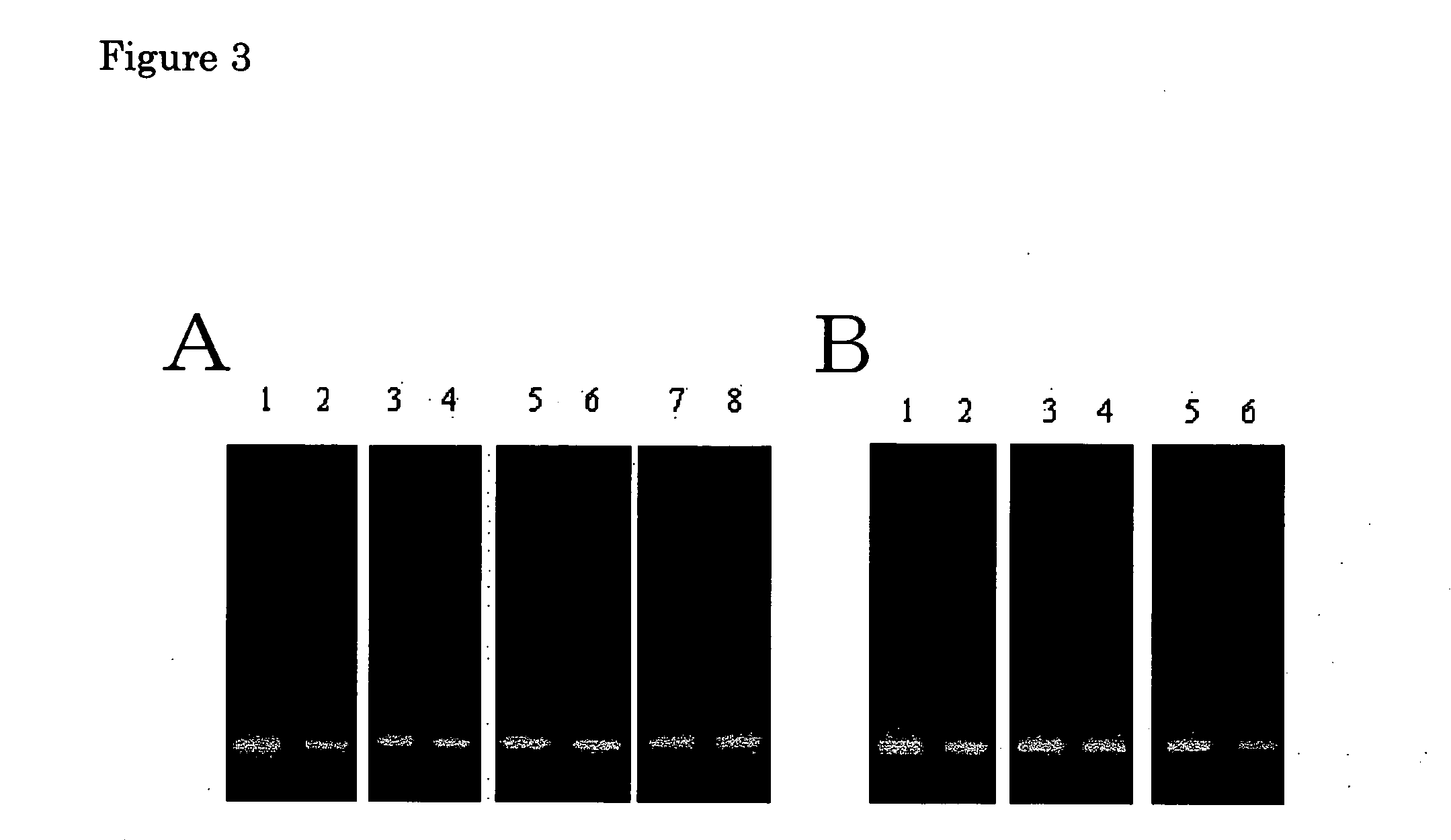Method of stabilizing reagent for amplifying or detecting nucleic acid and storage method
- Summary
- Abstract
- Description
- Claims
- Application Information
AI Technical Summary
Benefits of technology
Problems solved by technology
Method used
Image
Examples
referential example 1
[0169] (1) A unit value of a heat-resistant RNase H used for the method of the present invention was calculated as follows.
[0170] 1 mg of poly(rA) or poly(dT) (both from Amersham Pharmacia Biotech) was dissolved in 1 ml of 40 mM tris-HCl (pH 7.7) containing 1 mM EDTA to prepare a poly(rA) solution and a poly(dT) solution.
[0171] The poly(rA) solution (to a final concentration of 20 .mu.g / ml) and the poly(dT) solution (to a final concentration of 30 .mu.g / ml) were then added to 40 mM tris-HCl (pH 7.7) containing 4 mM MgCl.sub.2, 1 mM DTT, 0.003% BSA and 4% glycerol. The mixture was reacted at 37.degree. C. for 10 minutes and then cooled to 4.degree. C. at prepare a poly(rA)-poly(dT) solution. 1 .mu.l of an appropriately diluted enzyme solution was added to 100 .mu.l of the poly(rA)-poly(dT) solution. The mixture was reacted at 40.degree. C. for 10 minutes. 10 .mu.l of 0.5 M EDTA was added thereto to terminate the reaction. Absorbance at 260 nm was then measured. As a control, 10 .mu.l...
referential example 2
Preparation of RNase H
[0172] An RNase H used according to the present invention was prepared according to the method as-described in WO 02 / 22831. Specifically, Escherichia coli recombinant cells were cultured and an RNase H of interest was prepared from the cells as follows.
[0173] (1) Polypeptide Having RNase H Activity Derived from Pyrococcus furiosus
[0174] Escherichia coli JM109 transformed with a plasmid pPFU220 which contains a DNA encoding a polypeptide having an RNase H activity derived from Pyrococcus furiosus is designated and indicated as Escherichia coli JM109 / pPFU220, and deposited on Sep. 5, 2000 (date of original deposit) at International Patent Organism Depositary, National Institute of Advanced Industrial Science and Technology, AIST Tsukuba Central 6, 1-1, Higashi 1-chome, Tsukuba-shi, Ibaraki 305-8566, Japan under accession number FERM BP-7654. Escherichia coli JM109 transformed with pPFU220 was-inoculated into 2 L of LB medium containing 100 .mu.g / ml of ampicillin ...
referential example 3
[0192] The amplification method of the present invention was examined.
[0193] (1) A PCR was carried out using pUC19 upper 150 PCR primer (SEQ ID NO:1) and pUC19 lower PCR primer (SEQ ID NO:2), as well as 100 pg of pUC19 plasmid DNA as a template. The resulting amplified fragment was purified using Microcon-100, blunt-ended using DNA blunting kit (Takara Shuzo) and subcloned into a HincII site of the plasmid pUC19. The plasmid with the amplified fragment being inserted was used to transform Escherichia coli JM109. The transformant was cultured. The plasmid having the inserted DNA, pUC19-150, was purified from the cells using QIAGEN plasmid mini kit (Qiagen). A PCR was carried out using the plasmid having the inserted DNA as a template as well as primers MCS-F (SEQ ID NO:3) and MCS-R (SEQ ID NO:4). A 534-bp PCR amplified fragment was obtained by purifying the reaction mixture using Microcon-100 (Millipore). A reaction mixture containing 15 ng of the PCR fragment, 30 pmol of a primer MR...
PUM
| Property | Measurement | Unit |
|---|---|---|
| Concentration | aaaaa | aaaaa |
Abstract
Description
Claims
Application Information
 Login to View More
Login to View More - R&D
- Intellectual Property
- Life Sciences
- Materials
- Tech Scout
- Unparalleled Data Quality
- Higher Quality Content
- 60% Fewer Hallucinations
Browse by: Latest US Patents, China's latest patents, Technical Efficacy Thesaurus, Application Domain, Technology Topic, Popular Technical Reports.
© 2025 PatSnap. All rights reserved.Legal|Privacy policy|Modern Slavery Act Transparency Statement|Sitemap|About US| Contact US: help@patsnap.com



